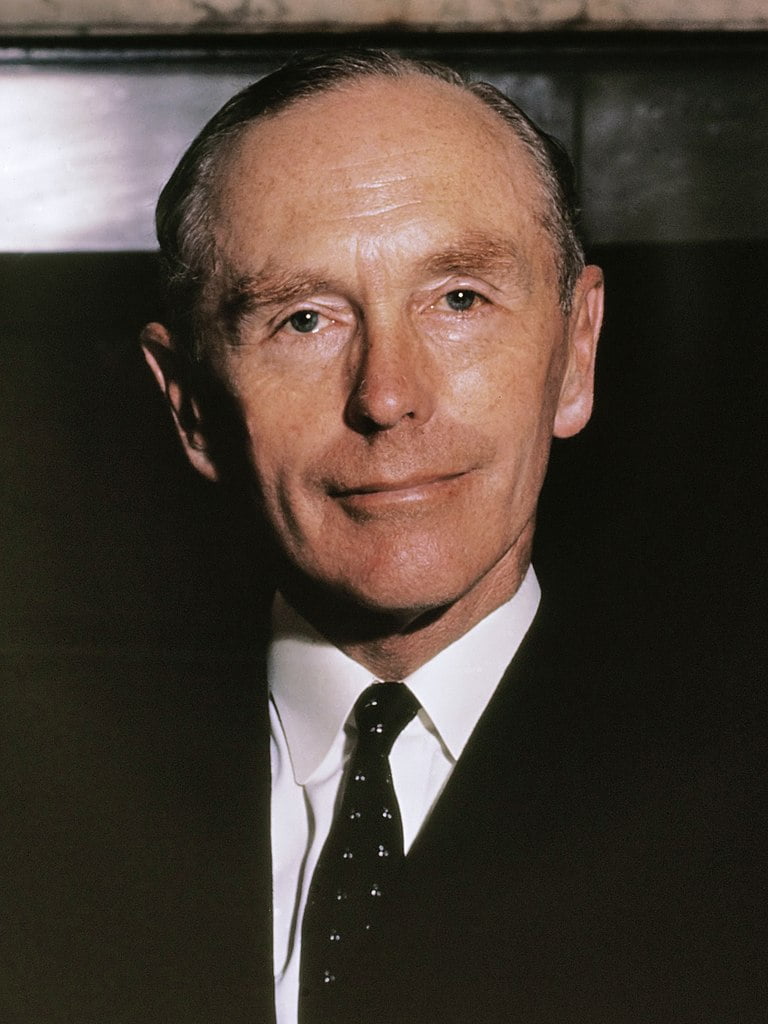Sir Alec Douglas-Home
Conservative Party
Image credit: A portrait of Sir Alec Douglas-Home the new UK Prime Minister, unknown photographer for Anefo Nationaal Archief, the Dutch National Archives.
Sir Alec Douglas-Home
There are two problems in my life. The political ones are insoluble and the economic ones are incomprehensible.
Conservative Party
October 1963 - October 1964
18 Oct 1963 - 16 Oct 1964

Image credit: A portrait of Sir Alec Douglas-Home the new UK Prime Minister, unknown photographer for Anefo Nationaal Archief, the Dutch National Archives.
Key Facts
Tenure dates
18 Oct 1963 - 16 Oct 1964
Length of tenure
363 days
Party
Conservative Party
Spouse
Elizabeth Alington
Born
2 Jul 1903
Birth place
London, England
Died
9 Oct 1995 (aged 92 years)
About Sir Alec Douglas-Home
Alec Douglas-Home stepped in as Prime Minister after Macmillan’s resignation. His premiership was the briefest of the 20th Century, lasting two days short of a year. He was the last genuine aristocrat to serve as Prime Minister, but, unlike his 19th Century forbears, had to disclaim his peerage at the beginning of his premiership.
Alec Douglas-Home was born in Mayfair in 1903, son of Lord Dunglass. His upbringing was conventional: Eton, followed by Christ Church College, Oxford.
During the 1920s, he played first-class cricket for Oxford University Cricket Club, Middlesex County Cricket Club, and Marylebone Cricket Club. He also served in the Territorial Army.
In 1931, he won the seat of Lanark for the Conservatives and entered the House of Commons. Douglas-Home (then known by his courtesy title of Lord Dunglass) became Parliamentary Private Secretary to Chancellor Neville Chamberlain. When Chamberlain became Prime Minister in 1937, he retained Dunglass as his PPS. Dunglass even accompanied Chamberlain on the Munich visit in September 1938.
When war began in 1939, Dunglass volunteered for military service. However, a medical examination revealed that he had a severely damaged spine and tuberculosis in his back bones. An operation was performed to remove the bone and replace it in September 1940. Then, for the next two years, he would be mostly bedbound, awaiting recovery. He only returned to the Commons in 1943. He was briefly a minister in Churchill’s Conservative government in May 1945. Dunglass lost his seat in the 1945 election.
Dunglass won Lanark back in 1950. In July 1951, the old earl died, and Dunglass succeeded him, becoming Earl of Home and entering the House of Lords. He had a variety of ministerial roles during the 1950s, largely focused on foreign policy. In March 1957, Macmillan made Home leader of the House of Lords. In 1960, Macmillan appointed Home Foreign Secretary, with Heath as his deputy in the Commons.
In October 1963, Macmillan resigned due to ill health. An opaque Conservative leadership contest followed, which saw Home appointed Prime Minister.
Home’s first task was to disclaim his peerage, after which he was known as Sir Alec Douglas-Home, and run for a safe seat. He quickly secured Kinross and West Perthshire, winning it on 12 November. For twenty days, Douglas-Home was a Prime Minister without a seat in either House of Parliament.
Douglas-Home’s premiership was too short lived for any significant legislation or reform. Douglas-Home was defeated in the 1964 election by Harold Wilson, who gained a majority of just 4 seats.
Douglas-Home is relatively unique amongst recent Prime Ministers to have returned to Cabinet after being Prime Minister. He was Foreign Secretary in Heath’s 1970-74 government. He returned to the Lords in 1975. He died in 1995.
Premiership
Douglas-Home’s premiership was too short lived for any significant legislation or reform.
By the time Douglas-Home became Prime Minister, the Conservatives had been in power for thirteen years, and most considered the government to be headed for a major election defeat. This was made worse by divisions within the Party, with some senior figures quite nonplussed about the way that aristocratic Douglas-Home had become Prime Minister. In the event, Douglas-Home was defeated in the 1964 election, but a Conservative disaster was averted, because Labour gained a majority of just 4 seats.
Notably, he represented Britain at the funeral of assassinated US President John F. Kennedy in November 1963.
Personal life
Douglas-Home married Elizabeth Arlington in 1936 and they had 4 children.
Key Events
Collections & Content
Andrew Bonar Law
Bonar Law was the shortest serving Prime Minister of the 20th Century, being in office for just 209 days. He was gravely ill when he t...
The Earl of Rosebery
Lord Rosebery was Gladstone’s successor and the most recent Prime Minister whose entire parliamentary career...
Arthur James Balfour
Arthur Balfour was Salisbury’s successor. He had a reputation as a good parliamentarian, a capable minister, and an excellent ta...
The Duke of Wellington
Wellington is a Prime Minister who is today largely remembered for achievements unrelated to his premiership. ...
The Duke of Grafton
The Duke of Grafton believed, according to Horace Walpole, that ‘the world should be postponed to a whore and a...
Benjamin Disraeli
Charming, brilliant, witty, visionary, colourful, and unconventional, Benjamin Disraeli (nicknamed ‘Dizzy’) was one of the greate...
Boris Johnson
Boris Johnson is one of the most charismatic and controversial politicians of the modern era. To supporters, he was an authentic voice wh...
The Earl Grey
Earl Grey was the great aristocratic reformer. His government passed the ‘Great Reform Act of 1832’, ending an entire e...


